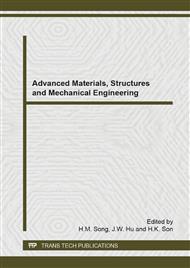p.355
p.361
p.366
p.372
p.379
p.385
p.391
p.395
p.405
Multiscale Model of Shape Rolling Taking into Account the Microstructure Evolution – Finite Element Modeling
Abstract:
The use of appropriate forming processes allows to obtain materials of required quality, which are fulfill different technological criteria. The basic type of properties, which are fundamental for material use in specific operating conditions, are mechanical ones. They directly depend on the microstructure. Model of microstructure evolution allows for multi-criteria optimization of technological processes in view of final product properties, taking into account technological conditions. The objective of this study is development a multiscale model of microstructure evolution during the shape rolling process and presentation the finite element modeling results for 5 mm round bars rolled in diamond, oval and round grooves. The model allows to obtain parameters of technological process (by means of finite element model - FEM) and microstructural parameters (with use cellular automata - CA). FEM is used for design and selection of the grooves on the first stage [1] and for the simulations of shape rolling process in macro scale on the second stage. The next stage includes the use of FEM modeling results for simulation of microstructure evolution by cellular automata. The article presents the simulation results of shape rolling (5 mm round bars in diamond - oval scheme) with used the finite element method. This stage is the second one in the calculation sequence of the developed multiscale model. The basic process parameters such as temperature, components of strain and strain rate tensors and strain rate intensity at arbitrary points of deformed material are the modeling results. Selected FEM simulation results are presented in the article.
Info:
Periodical:
Pages:
379-384
Citation:
Online since:
September 2014
Authors:
Price:
Сopyright:
© 2014 Trans Tech Publications Ltd. All Rights Reserved
Share:
Citation:


